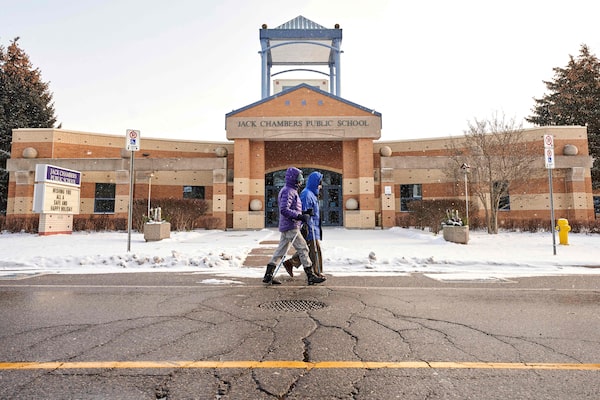
Jack Chambers Public School in London, Ont., on Jan. 6, the day after the province transitioned to online learning in the face of the fast spreading Omicron variant of COVID-19.GEOFF ROBINS/AFP/Getty Images
Ontario’s school officials are bracing for staff shortages – and the prospect of individual school closings – caused by the fast-spreading Omicron variant of COVID-19 when they open their doors to the province’s two million students on Monday.
Plans are being made to reassign support staff and non-certified instructors to classrooms if there are not enough substitute teachers to fill the gaps. And if the situation worsens, school board officials are looking at rotating virtual learning days, so that supply teachers could be spread out among the various classrooms.
The province’s Education Minister, Stephen Lecce, said that during the time schools were closed to in-person learning, his government shipped N95 masks for school staff and accelerated booster shots for education and childcare workers; as well it is preparing to deploy 3,000 HEPA filters on top of the existing 70,000 already in schools. He also said the province reached an agreement with the Ontario Teachers’ Federation that would allow retirees to work for 95 days, up from 50, to address the staff shortages.
“Recognizing the challenges posed by the Omicron, these measures will help stabilize the school work force as we continue to do everything we can to keep kids learning,” Mr. Lecce said in a statement on Tuesday. He is expected to announce more details on schools reopening on Wednesday.
All provinces except Saskatchewan extended the holiday break or moved students to virtual learning in the new year – an opportunity to enhance layers of protection in schools against the Omicron variant, doctors said. Ontario Premier Doug Ford said he closed schools to in-person learning because hospitalizations were rising, but also to implement more safety measures and give time for students and staff to get vaccinated. Quebec students are also expected to return to classrooms on Jan. 17.
Pino Buffone, director of education at the Renfrew County District School Board in eastern Ontario, said staff absences is in the 10-to-18-per-cent range at this time, and he is expecting it to be higher next week.
The board has drafted a plan on how it will handle staff shortages. It includes redeploying non-classroom teaching staff and uncertified instructors if administrators are unable to temporarily fill teaching positions. In past exceptional circumstances, boards have asked people without a teaching certificate to step in because of a shortage of substitutes. Such individuals require a police background check.
Individual schools could be closed “in the event we can’t manage” and there is not enough staff to keep students safe, Mr. Buffone said. “We do want kids back in schools and in classes. We’re going to do our very best, but it will be a little more fluid than, I think, what we’ve experienced even in the pandemic context so far.”
Ryan Bird, a spokesman for the Toronto District School Board, the country’s largest, said that while it is difficult to predict how staff absences will affect nearly 600 schools, the board is working on strategies, including the redeployment of central office staff and inviting retired teachers into classrooms. Individual classes or entire schools could be moved temporarily online, he added, “however that will be based on the unique circumstances at each school.”
The province has told school officials that they can combine classes or assign students to different classrooms to ensure supervision. Boards are also permitted to rotate remote learning days up to one day a week, if necessary, according to a memo sent to school boards at the end of December, a copy of which was obtained by The Globe and Mail.
Cathy Abraham, president of the Ontario Public School Boards’ Association, said those measures would only be used if the situation worsens.
“Our main focus is that kids have a safe opportunity to be in school with a teacher that is going to be providing them with their education,” she said. “How that looks and how that works will vary across the province. We do know there will be some struggles with teachers and staffing.”
Only schools in British Columbia, Alberta and Saskatchewan have opened their doors to in-person learning. Governments have faced the challenge of balancing the risk of COVID-19, which is relatively mild in children, with the social and academic harms caused by missing in-person learning.
In Alberta, where schools reopened on Monday, boards have seen an increase in staff absences. Edmonton Public Schools reported 494 absent teachers on Tuesday, up from 454 the previous day. Of those vacancies, 36 could not be covered using the usual substitute pool (up from 22 the day prior), so the division deployed 29 “temporary contract teachers” hired earlier this month, spokeswoman Megan Normandeau said.
Megan Geyer, a spokeswoman for the Calgary Board of Education, said on Tuesday that the board’s employee absentee rate was 50 per cent higher than the three-year average for this time of year. The board counted 751 absent teachers Tuesday, up from 681 on Monday. The board was able to fill 555 of those spots, leaving about 27 per cent of the vacancies uncovered.
- With files from Carrie Tait in Alberta
Our Morning Update and Evening Update newsletters are written by Globe editors, giving you a concise summary of the day’s most important headlines. Sign up today.
 Caroline Alphonso
Caroline Alphonso